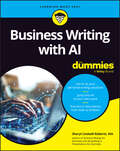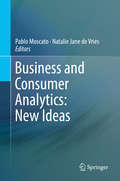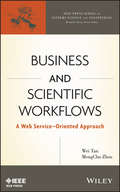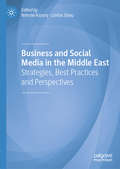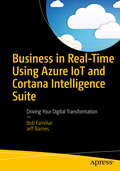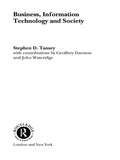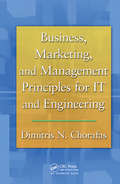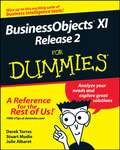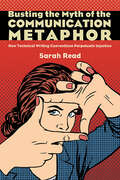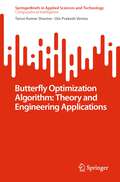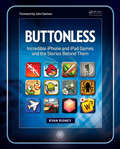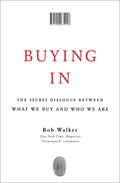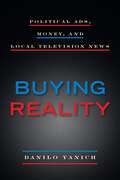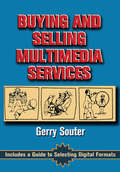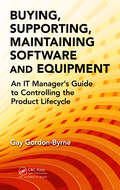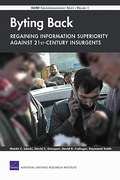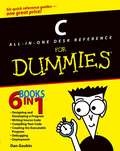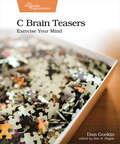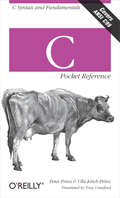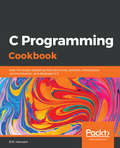- Table View
- List View
Business Trends in Practice: The 25+ Trends That are Redefining Organizations
by Bernard MarrStay one step ahead of the competition with this expert review of the most impactful and disruptive business trends coming down the pike Far from slowing down, change and transformation in business seems to come only at a more and more furious rate. The last ten years alone have seen the introduction of groundbreaking new trends that pose new opportunities and challenges for leaders in all industries. In Business Trends in Practice: The 25+ Trends That Are Redefining Organizations, best-selling business author and strategist Bernard Marr breaks down the social and technological forces underlying these rapidly advancing changes and the impact of those changes on key industries. Critical consumer trends just emerging today—or poised to emerge tomorrow—are discussed, as are strategies for rethinking your organisation’s product and service delivery. The book also explores: Crucial business operations trends that are changing the way companies conduct themselves in the 21st century The practical insights and takeaways you can glean from technological and social innovation when you cut through the hype Disruptive new technologies, including AI, robotic and business process automation, remote work, as well as social and environmental sustainability trends Business Trends in Practice: The 25+ Trends That Are Redefining Organizations is a must-read resource for executives, business leaders and managers, and business development and innovation leads trying to get – and stay – on top of changes and disruptions that are right around the corner.
Business Writing with AI For Dummies
by Sheryl Lindsell-RobertsLearn how to generate high quality, business documents with AI This essential guide helps business writers and other professionals learn the strengths and weaknesses of AI as a writing assistant. You'll discover how AI can help you by chopping through writer's block, drafting an outline, generating headlines and titles, producing meaningful text, maintaining consistency, proofreading and editing, and optimizing content for search engines. Employees in all industries spend enormous amounts of energy writing, editing, and proofreading documents of all kinds. Now, you can improve your efficiency and boost the quality of your work, thanks to AI writing tools like ChatGPT, Jaspar, Grammarly, and beyond. With clear instructions and simple tips, Business Writing with AI For Dummies guides you through the process of using AI for common business writing tasks. Produce high quality, specialized writing quicker and at a lower cost Use AI to draft business-related content like emails, articles, business plans, grant proposals, bios, websites, and many others Incorporate AI into your writing process to make your workday more efficient Take advantage of AI so you can focus your human creativity on going beyond the basics For business professionals facing tight deadlines or large volumes of writing tasks, this easy-to-use Dummies guide will be a game changer.
Business and Consumer Analytics: New Ideas
by Pablo Moscato Natalie Jane de VriesThis two-volume handbook presents a collection of novel methodologies with applications and illustrative examples in the areas of data-driven computational social sciences. Throughout this handbook, the focus is kept specifically on business and consumer-oriented applications with interesting sections ranging from clustering and network analysis, meta-analytics, memetic algorithms, machine learning, recommender systems methodologies, parallel pattern mining and data mining to specific applications in market segmentation, travel, fashion or entertainment analytics. A must-read for anyone in data-analytics, marketing, behavior modelling and computational social science, interested in the latest applications of new computer science methodologies.The chapters are contributed by leading experts in the associated fields.The chapters cover technical aspects at different levels, some of which are introductory and could be used for teaching. Some chapters aim at building a common understanding of the methodologies and recent application areas including the introduction of new theoretical results in the complexity of core problems. Business and marketing professionals may use the book to familiarize themselves with some important foundations of data science. The work is a good starting point to establish an open dialogue of communication between professionals and researchers from different fields.Together, the two volumes present a number of different new directions in Business and Customer Analytics with an emphasis in personalization of services, the development of new mathematical models and new algorithms, heuristics and metaheuristics applied to the challenging problems in the field. Sections of the book have introductory material to more specific and advanced themes in some of the chapters, allowing the volumes to be used as an advanced textbook. Clustering, Proximity Graphs, Pattern Mining, Frequent Itemset Mining, Feature Engineering, Network and Community Detection, Network-based Recommending Systems and Visualization, are some of the topics in the first volume. Techniques on Memetic Algorithms and their applications to Business Analytics and Data Science are surveyed in the second volume; applications in Team Orienteering, Competitive Facility-location, and Visualization of Products and Consumers are also discussed. The second volume also includes an introduction to Meta-Analytics, and to the application areas of Fashion and Travel Analytics. Overall, the two-volume set helps to describe some fundamentals, acts as a bridge between different disciplines, and presents important results in a rapidly moving field combining powerful optimization techniques allied to new mathematical models critical for personalization of services. Academics and professionals working in the area of business anyalytics, data science, operations research and marketing will find this handbook valuable as a reference. Students studying these fields will find this handbook useful and helpful as a secondary textbook.
Business and Scientific Workflows: A Web Service-Oriented Approach (IEEE Press Series on Systems Science and Engineering #5)
by Wei Tan MengChu ZhouFocuses on how to use web service computing and service-based workflow technologies to develop timely, effective workflows for both business and scientific fields Utilizing web computing and Service-Oriented Architecture (SOA), Business and Scientific Workflows: A Web Service–Oriented Approach focuses on how to design, analyze, and deploy web service–based workflows for both business and scientific applications in many areas of healthcare and biomedicine. It also discusses and presents the recent research and development results. This informative reference features application scenarios that include healthcare and biomedical applications, such as personalized healthcare processing, DNA sequence data processing, and electrocardiogram wave analysis, and presents: Updated research and development results on the composition technologies of web services for ever-sophisticated service requirements from various users and communities Fundamental methods such as Petri nets and social network analysis to advance the theory and applications of workflow design and web service composition Practical and real applications of the developed theory and methods for such platforms as personalized healthcare and Biomedical Informatics Grids The authors' efforts on advancing service composition methods for both business and scientific software systems, with theoretical and empirical contributions With workflow-driven service composition and reuse being a hot topic in both academia and industry, this book is ideal for researchers, engineers, scientists, professionals, and students who work on service computing, software engineering, business and scientific workflow management, the internet, and management information systems (MIS).
Business and Social Media in the Middle East: Strategies, Best Practices and Perspectives
by Nehme Azoury Lindos DaouThis book discusses the effectiveness of Western organizations’ social media strategies in the Middle East. Social media has changed the rules of doing business, but the exact impacts vary across regions. In the context of Middle Eastern societies, social media is seen as a way for individuals and communities to communicate with each other and is generally not viewed as a means for brands to interact with individuals. Examining how the use of social media in the Middle East is shaped by the region’s culture, authors discuss the factors that businesses need to consider when creating digital marketing strategies targeted there. Including case studies of Middle Eastern companies, this book provides a comprehensive analysis of the rise of social media in the MENA region and the often-neglected role of culture in research in this area. It will provide researchers and practitioners with a deeper understanding of conducting business in the Middle East through the effective and efficient use of social media.
Business in Real-Time Using Azure IoT and Cortana Intelligence Suite
by Jeff Barnes Bob FamiliarLearn how today’s businesses can transform themselves by leveraging real-time data and advanced machine learning analytics. This book provides prescriptive guidance for architects and developers on the design and development of modern Internet of Things (IoT) and Advanced Analytics solutions. In addition, Business in Real-Time Using Azure IoT and Cortana Intelligence Suite offers patterns and practices for those looking to engage their customers and partners through Software-as-a-Service solutions that work on any device.Whether you're working in Health & Life Sciences, Manufacturing, Retail, Smart Cities and Buildings or Process Control, there exists a common platform from which you can create your targeted vertical solutions. Business in Real-Time Using Azure IoT and Cortana Intelligence Suite uses a reference architecture as a road map. Building on Azure’s PaaS services, you'll see how a solution architecture unfolds that demonstrates a complete end-to-end IoT and Advanced Analytics scenario.What You'll Learn:Automate your software product life cycle using PowerShell, Azure Resource Manager Templates, and Visual Studio Team ServicesImplement smart devices using Node.JS and C#Use Azure Streaming Analytics to ingest millions of eventsProvide both "Hot" and "Cold" path outputs for real-time alerts, data transformations, and aggregation analyticsImplement batch processing using Azure Data FactoryCreate a new form of Actionable Intelligence (AI) to drive mission critical business processesProvide rich Data Visualizations across a wide variety of mobile and web devices Who This Book is For:Solution Architects, Software Developers, Data Architects, Data Scientists, and CIO/CTA Technical Leadership Professionals
Business, Information Technology and Society
by Stephen D. TanseyThis comprehensive volume introduces the nature and the impact of the new information and communication technologies on business and society. Emphasizing the global impact, it draws upon examples from the USA, Europe, and Japan as well as the newly industrialized countries of the Pacific Rim. Applying a systems thinking approach, author Stephen D. Tansey covers: the environment of computing the IT industry, government and the information economy - and the recent development of e-government initiatives the need to regulate computing the role of IT in the workplace: its effect on organizations and jobs the impact of IT on society at large. Written for students studying business or IT, this book is an invaluable resource offering topical insights into the ways in which information technology is shaping our work and our lives. Without assuming any prior knowledge of either business or IT, this key text provides a unique, essential guide.
Business, Marketing, and Management Principles for IT and Engineering
by Dimitris N. ChorafasIn order to achieve long-term profitability and assure survival for their companies, managers must be informed, imaginative, and capable of adapting to shifting circumstances. Practical decisions rather than theories hold the upper ground. Business, Marketing, and Management Principles for IT and Engineering supplies the understanding required to e
BusinessObjects XI Release 2 For Dummies
by Derek Torres Stuart Mudie Julie AlbaretBusinessObjects may seem like a dauntingly complex topic, but BusinessObjects XI Release 2 For Dummies makes is a snap. Even if you're new to business intelligence tools, this user-friendly guide makes it easy to access, format and share data, analyze the information this data contains, and measure your organization's performance.In no time, you'll be finding your way around Universes to see how everything is shaping up, viewing and creating reports, building powerful queries on your organizations database, and measuring your company's performance using BusinessObjects XI Release 2. This completely jargon-free handbook will put you in complete control of the ways and means of a truly exciting and powerful suite of business intelligence tools. Discover how to:Make business decisions with help from BusinessObjectsUse BusinessObjects XI wizardsPerform a server installationCreate and define a UniverseSet up desktop reportingCustomize and use InfoViewMeasure performance with Dashboard and AnalyticsTake advantage of data marts and understand how they fit into your BusinessObjects systemCreated by a team with more than 15 years combined experience working with BusinessObjects tools, BusinessObjects XI Release 2 For Dummies comes complete with several short lists of useful information, including tips on how to prepare for a successful BusinessObjects integration and helpful resources beyond the pages of this book. You'll also find an overview of Crystal Reports, BusinessObjects' companion reporting tool.
Busting the Myth of the Communication Metaphor: How Technical Writing Conventions Perpetuate Injustice (SUNY series, Studies in Technical Communication)
by Sarah ReadTraces the linguistic, rhetorical, historical, cultural, and economic origins of our most basic beliefs and practices for successful technical writing to initiate a reckoning about who they serve and who they harm.Busting the Myth of the Communication Metaphor is a transdisciplinary approach to making visible and explaining the multiple origins of why our most basic beliefs about what makes scientific and technical writing successful are wrong, ineffective, and harmful. These tacitly held beliefs and practices, collectively called the Communication Metaphor, stand in as symbolic for a messier, more reality-based understanding of how writing and communication works. By starting from conventional statements made by scientists, technical professionals, and standard textbooks that "successful technical writing is short and to the point, with the facts only, no opinions," the book traces the histories and structures of the multiple elements of the Communication Metaphor. The text synthesizes survey results, multiple strands of scholarship, personal experience, and original illustrations into a powerful argument for imagining a more just approach to scientific and technical writing.
Butterfly Optimization Algorithm: Theory and Engineering Applications (SpringerBriefs in Applied Sciences and Technology)
by Om Prakash Verma Tarun Kumar SharmaThis book presents theory and applications of recently introduced butterfly optimization algorithm (BOA). It also highlights hybridization process in the basic structure of BOA with in-depth analysis of complexity. This book also describes the constraint handling process. The newly introduced variant is implemented and validated on a set of linear and nonlinear real works problems of engineering and pulp and paper industry. The simulated results are compared with most of the basic algorithms. Comparative and nonparametric statistical result analysis illustrates the efficacy of the algorithm.
Buttonless: Incredible iPhone and iPad Games and the Stories Behind Them
by Ryan RigneyThis book presents some of the most interesting iPhone and iPad games, along with stories of the people behind these games. It describes hundreds of titles, including well-known games and hidden games, and provides insight into the development of games for the iOS platform.
Buy Now: How Amazon Branded Convenience and Normalized Monopoly (Distribution Matters)
by Emily WestHow Amazon combined branding and relationship marketing with massive distribution infrastructure to become the ultimate service brand in the digital economy.Amazon is ubiquitous in our daily lives—we stream movies and television on Amazon Prime Video, converse with Alexa, receive messages on our smartphone about the progress of our latest orders. In Buy Now, Emily West examines Amazon&’s consumer-facing services to investigate how Amazon as a brand grew so quickly and inserted itself into so many aspects of our lives even as it faded into the background, becoming a sort of infrastructure that can be taken for granted. Amazon promotes the comfort and care of its customers (but not its workers) to become the ultimate service brand in the digital economy. West shows how Amazon has cultivated personalized, intimate relationships with consumers that normalize its outsized influence on our selves and our communities. She describes the brand&’s focus on speedy and seamless ecommerce delivery, represented in the materiality of the branded brown box; the positioning of its book retailing, media streaming, and smart speakers as services rather than sales; and the brand&’s image control strategies. West considers why pushback against Amazon&’s ubiquity and market power has come mainly from among Amazon&’s workers rather than its customers or competitors, arguing that Amazon&’s brand logic fragments consumers as a political bloc. West&’s innovative account, the first to examine Amazon from a critical media studies perspective, offers a cautionary cultural study of bigness in today&’s economy.
Buying In: The Secret Dialogue Between What We Buy and Who We Are
by Rob Walker"Fascinating ... A compelling blend of cultural anthropology and business journalism."-- Andrea Sachs, Time Magazine. "An often startling tour of new cultural terrain."-- Laura Miller, Salon. "Marked by meticulous research and careful conclusions, this superbly readable book confirms New York Times journalist Walker as an expert on consumerism. ... [A] thoughtful and unhurried investigation into consumerism that pushes the analysis to the maximum..."--Publisher's Weekly (starred review). Brands are dead. Advertising no longer works. Weaned on TiVo, the Internet, and other emerging technologies, the short-attention-span generation has become immune to marketing. Consumers are "in control." Or so we're told. In Buying In, New York Times Magazine "Consumed" columnist Rob Walker argues that this accepted wisdom misses a much more important and lasting cultural shift. As technology has created avenues for advertising anywhere and everywhere, people are embracing brands more than ever before--creating brands of their own and participating in marketing campaigns for their favorite brands in unprecedented ways. Increasingly, motivated consumers are pitching in to spread the gospel virally, whether by creating Internet video ads for Converse All Stars or becoming word-of-mouth "agents" touting products to friends and family on behalf of huge corporations. In the process, they (and we) have begun to funnel cultural, political, and community activities through connections with brands. Walker explores this changing cultural landscape, including a practice he calls "murketing," blending the terms murky and marketing, by introducing us to the creative marketers, entrepreneurs, artists, and community organizers who have found a way to thrive within it. Using profiles of brands old and new, including Timberland, American Apparel, Pabst Blue Ribbon, Red Bull, iPod, and Livestrong, Walker demonstrates the ways in which buyers adopt products, not just as consumer choices, but as conscious expressions of their identities. Part marketing primer, part work of cultural anthropology, Buying In reveals why now, more than ever, we are what we buy--and vice versa. Praise for Buying In: "Walker ... makes a startling claim: Far from being immune to advertising, as many people think, American consumers are increasingly active participants in the marketing process. ... [He] leads readers through a series of lucid case studies to demonstrate that, in many cases, consumers actively participate in infusing a brand with meaning. ... Convincing."-- Jay Dixit, The Washington Post. "Walker lays out his theory in well-written, entertaining detail."-- Seth Stevenson, Slate. "Buying In delves into the attitudes of the global consumer in the age of plenty, and, well, we aren't too pretty. Walker carries the reader on a frenetically paced tour of senseless consumption spanning from Viking ranges to custom high-tops."-- Robert Blinn, Core77, "Rob Walker is one smart shopper."-- Jen Trolio, ReadyMade. "The most trenchant psychoanalyst of our consumer selves is Rob Walker. This is a fresh and fascinating exploration of the places where material culture and identity intersect." -Michael Pollan, author of In Defense of Food.
Buying Reality: Political Ads, Money, and Local Television News (Donald McGannon Communication Research Center's Everett C. Parker Book Series)
by Danilo YanichFrom a certain perspective, the biggest political story of 2016 was how the candidate who bought three-quarters of the political ads lost to the one whose every provocative Tweet set the agenda for the day’s news coverage. With the arrival of bot farms, microtargeted Facebook ads, and Cambridge Analytica, isn’t the age of political ads on local TV coming to a close?You might think. But you’d be wrong to the tune of $4.4 billion just in 2016. In U.S. elections, there’s a lot more at stake than the presidency. TV spending has gone up dramatically since 2006, for both presidential and down-ballot races for congressional seats, governorships, and state legislatures—and the 2020 campaign shows no signs of bucking this trend. When candidates don’t enjoy the name recognition and celebrity of the presidential contenders, it’s very much business as usual. They rely on the local TV newscasts, watched by 30 million people every day—not Tweets—to convey their messages to an audience more fragmented than ever. At the same time, the nationalization of news and consolidation of local stations under juggernauts like Nexstar Media and Sinclair Broadcasting mean a decreasing share of time devoted to down-ballot politics—almost 90 percent of 2016’s local political stories focused on the presidential race. Without coverage of local issues and races, ad buys are the only chance most candidates have to get their messages in front of a broadcast audience. On local TV news, political ads create the reality of local races—a reality that is not meant to inform voters but to persuade them. Voters are left to their own devices to fill in the space between what the ads say—the bought reality—and what political stories used to cover.
Buying and Selling Multimedia Services
by Gerry SouterThis book is a comprehensive guide to buying and developing multimedia in the most cost-effective manner. Focusing on the human factors in producing multimedia, rather than just the software, Buying and Selling Multimedia Services is aimed at both buyers and sellers of multimedia services and draws on real-world anecdotes¦war stories¦from project diaries and first-hand experience, to provide examples of the key ideas delineated within the book. These are true stories culled from 25 years of working on both sides of the desk as a purchaser of creative services for a Fortune 500 company and as a producer and seller for one of the largest multimedia production shops in the country. This book helps the multimedia producer and buyer to recognize flaws in past performances and to anticipate situations in future projects in order to save money and eliminate boardroom confrontations. Accusations, altercations, and recriminations can be avoided and the bottom line enhanced with the production of an effective product targeted to a receptive audience. Souter examines the skills necessary to both the producer and the purchaser of multimedia, allowing each to see the others' problems and viewpoints. Viewing the multimedia project from both sides, as both buyer and seller, Souter highlights the issues which will allow for effective communication between parties, resulting in a better product and a more creative relationship among all involved. In the second part of the book, Souter provides a comprehensive guide to all the digital formats available, to help the buyer and the developer select the most appropriate for a given project.
Buying the Right Photo Equipment
by Elin RantakransWe've all heard the saying, "Clothes make the man"; but does the photographic equipment make the photographer? One might think so when looking at new advanced cameras, dream lenses, and all the editing software out there. Others might disagree after admiring the wonderful photographs by Henri Cartier Bresson or Edward Weston, which were taken with relatively simple cameras and lenses. The real questions to ask yourself are: What kind of images would I like to make? And what are all these things that I see advertised as indispensable photo equipment really for? Geared toward the beginning to intermediate photographer, this book teaches about the variety of photographic tools available and what each is meant to accomplish. Learn about the benefits and drawbacks of various pieces of equipment and discover what kind of gear you need to realize your creative ambitions. The book is filled with beautiful images that illustrate how the type of equipment discussed can affect an image.
Buying, Supporting, Maintaining Software and Equipment: An IT Manager's Guide to Controlling the Product Lifecycle
by Gay Gordon-ByrneDescribing how to avoid common vendor traps, Buying, Supporting, Maintaining Software and Equipment: An IT Manager's Guide to Controlling the Product Lifecycle will help readers better control the negotiation of their IT products and services and, ultimately, better manage the lifecycle of those purchases. The book supplies an inside look at the methods and goals of vendors and their contracts-which are almost always in conflict with end-user goals. The text is set up to follow the way most people experience technology products and contracting decisions. It begins by explaining the significance of the decisions made at the time of product selection. It details what you need to focus on when negotiating service and support agreements and describes how to use purchase orders to negotiate more favorable agreements. Covers product acquisition, support, and maintenance Examines hardware and software warranty and support models Considers finance and accounting issues for maintenance and support Spells out technology product details Explains postwarranty support and maintenance Provides the understanding to better negotiate with vendor sales teams Illustrating the types of problems typically experienced during product use, the book describes how to better control the useful life of your equipment. It supplies tips on how to avoid excessive charges from predatory vendors and concludes by delving into issues of product end of life. Explaining how to manage support and maintenance issues for the long term, this book provides the understanding you need to make sure you are more knowledgeable about the products and services your organization needs than the vendor teams with whom you are negotiating.
BuzzFeed Ultimate Book of Quizzes: Questions and Answers on Life, Love, Food, Friendship, TV, Movies, and More
by BuzzFeedHilarious, entertaining, and irresistibly binge-worthy, this officially licensed ultimate collection of BuzzFeed quizzes -- from the most popular to the never-before-published -- includes hundreds of questions on everything you love all in one place!If you've been on the internet, chances are you've taken a BuzzFeed quiz or three in your lifetime. And if so, you probably know which Friends character you are or what your favorite fruit says about you. For years, BuzzFeed quizzes have made the rounds online and have gone crazy viral for a good reason -- they're fun, interactive, and super shareable. For the first time ever, BuzzFeed brings you one jam-packed book overflowing with 200 quizzes covering love, food, friendship, TV, movies, personality, and everything under the pop-culture sun. So whether you want to know which Disney character is your soul mate, where you should go on your next vacation, or what age you really are, gather your closest friends, break out the gel pens, and crack this quiz book open to find out.
Byting Back: Regaining Information Superiority Against 21st-Century Insurgents
by Raymond Smith David C. Gompert David R. Frelinger Martin C. LibickiU.S. counterinsurgency efforts in Iraq and Afghanistan have failed to exploit information power, which could be a U.S. advantage but instead is being used advantageously by insurgents. Because insurgency and counterinsurgency involve a battle for the allegiance of a population between a government and an armed opposition movement, the key to exploiting information power is to connect with and learn from the population itself, increasing the effectiveness of both the local government and the U.S. military and civilian services engaged in supporting it. Utilizing mostly available networking technology, the United States could achieve early, affordable, and substantial gains in the effectiveness of counterinsurgency by more open, integrated, and inclusive information networking with the population, local authorities, and coalition partners. The most basic information link with the population would be an information technology (IT)-enhanced, fraud-resistant registry-census. The most promising link would come from utilizing local cell phone networks, which are proliferating even among poor countries. Access to data routinely collected by such networks can form the basis for security services such as enhanced-911 and forensics. The cell phones of a well-wired citizenry can be made tantamount to sensor fields in settled areas. They can link indigenous forces with each other and with U.S. forces without interoperability problems; they can also track the responses of such forces to emergencies. Going further, outfitting weaponry with video cameras would bolster surveillance, provide lessons learned, and guard against operator misconduct. Establishing a national Wiki can help citizens describe their neighborhoods to familiarize U.S. forces with them and can promote accountable service delivery. All such information can improve counterinsurgency operations by making U.S. forces and agencies far better informed than they are at present. The authors argue that today?'s military and intelligence networks-being closed, compartmentalized, controlled by information providers instead of users, and limited to U.S. war fighters-hamper counterinsurgency and deprive the United States of what ought to be a strategic advantage. In contrast, based on a review of 160 requirements for counterinsurgency, the authors call for current networks to be replaced by an integrated counterinsurgency operating network (ICON) linking U.S. and indigenous operators, based on principles of inclusiveness, integration, and user preeminence. Utilizing the proposed ways of gathering information from the population, ICON would improve the timeliness, reliability, and relevance of information, while focusing security restrictions on truly sensitive information. The complexity and sensitivity of counterinsurgency call for vastly better use of IT than has been seen in Iraq and Afghanistan. Here is a practical plan for just that.
C All-in-One Desk Reference For Dummies
by Dan GookinCovers everything users need to get up to speed on C programming, including advanced topics to take their programming skill to the next level Walks C programmers through the entire development cycle of a C program-designing and developing the program, writing source code, compiling the code, linking the code to create the executable programs, debugging, and deployment Provides thorough coverage of keywords, program flow, conditional statements, constants and variables, numeric values, arrays, strings, functions, pointers, debugging, prototyping, and much more Addresses some advanced programming topics such as graphics and game programming as well as Windows and Linux programming Includes dozens of sample programs that readers can adapt and modify for their own uses Written by the author of the first-ever For Dummies book-a man known for his ability to take complex material and present it in a way that makes it simple and fun
C Brain Teasers
by Dan GookinYou thought you knew C, but can you solve 25 puzzles in this popular programming language? Noted C programmer and author Dan Gookin provides a series of pointed questions, puzzles, and problems to keep your C programming skills sharp. Each one will provide insight into various aspects of handling strings, numeric operations, and other activities, giving you techniques to take the best advantage of all C has to offer. Challenge yourself, and get to know some powerful tricks and details for writing better, faster, more accurate C code. Most C programming books present the information sequentially, teaching you the right way to code and only rarely describing what could go wrong. In this book, the goal is to find out what did go wrong - or what potentially goes right. Explore interesting and unusual programming concepts and approaches with small, to-the-point, programs and exercises. Hone your C programming skills and expand your knowledge. By working through the brain teasers in this book, you'll fill in gaps in your knowledge and work with advanced concepts such as pointers and recursion. All of the teaser topics were selected to give you food for thought, explaining the technical details behind each puzzle. Look at a code sample and try to guess what output it will give. Code it yourself and see the result. Is it what you expected? Then read the author's lighthearted explanation of exactly why the language does what it does, and how you can take advantage of it. You'll come away with a much better understanding of how the language works, and how to use it for efficient and effective programming. What You Need: You need to know the basics of coding in C, and have an environment for compiling and executing your C code. Any Windows, MacOS, or Linux system with a C compiler does the job. Use the terminal window for traditional C programming. Or obtain an Integrated Development Enviornment (IDE) such as Visual Studio Code, which contains all the software tools you need: Editor, Compiler, and Output.
C Pocket Reference: C Syntax and Fundamentals
by Peter Prinz Ulla Kirch-PrinzC is one of the oldest programming languages and still one of the most widely used. Whether you're an experienced C programmer or you're new to the language, you know how frustrating it can be to hunt through hundreds of pages in your reference books to find that bit of information on a certain function, type or other syntax element. Or even worse, you may not have your books with you. Your answer is the C Pocket Reference. Concise and easy to use, this handy pocket guide to C is a must-have quick reference for any C programmer. It's the only C reference that fits in your pocket and is an excellent companion to O'Reilly's other C books.Ideal as an introduction for beginners and a quick reference for advanced programmers, the C Pocket Reference consists of two parts: a compact description of the C language and a thematically structured reference to the standard library. The representation of the language is based on the ANSI standard and includes extensions introduced in 1999. An index is included to help you quickly find the information you need.This small book covers the following:C language fundamentalsData typesExpressions and operatorsC statementsDeclarationsFunctionsPreprocessor directivesThe standard libraryO'Reilly's Pocket References have become a favorite among programmers everywhere. By providing a wealth of important details in a concise, well-organized format, these handy books deliver just what you need to complete the task at hand. When you've reached a sticking point in your work and need to get to a solution quickly, the new C Pocket Reference is the book you'll want to have.
C Primer Plus
by Stephen PrataC Primer Plus is a carefully tested, well-crafted, and complete tutorial on a subject core to programmers and developers. This computer science classic teaches principles of programming, including structured code and top-down design. Author and educator Stephen Prata has created an introduction to C that is instructive, clear, and insightful. Fundamental programming concepts are explained along with details of the C language. Many short, practical examples illustrate just one or two concepts at a time, encouraging readers to master new topics by immediately putting them to use. Review questions and programming exercises at the end of each chapter bring out the most critical pieces of information and help readers understand and digest the most difficult concepts. A friendly and easy-to-use self-study guide, this book is appropriate for serious students of programming, as well as developers proficient in other languages with a desire to better understand the fundamentals of this core language. The sixth edition of this book has been updated and expanded to cover the latest developments in C as well as to take a detailed look at the new C11 standard. In C Primer Plus you'll find depth, breadth, and a variety of teaching techniques and tools to enhance your learning: Complete, integrated discussion of both C language fundamentals and additional features Clear guidance about when and why to use different parts of the language Hands-on learning with concise and simple examples that develop your understanding of a concept or two at a time Hundreds of practical sample programs Review questions and programming exercises at the end of each chapter to test your understanding Coverage of generic C to give you the greatest flexibility
C Programming Cookbook: Over 40 recipes exploring data structures, pointers, interprocess communication, and database in C
by B.M. HarwaniA comprehensive guide with curated recipes to help you gain a deeper understanding of modern C. Key Features Learn how to make your applications swift and robust by leveraging powerful features of C Understand the workings of arrays, strings, functions, and more down to how they operate in memory Master process synchronization during multi-tasking and server-client process communication Book Description C is a high-level language that's popular among developers. It enables you to write drivers for different devices, access machine-level hardware, apply dynamic memory allocation, and much more. With self-contained tutorials, known as recipes, this book will guide you in dealing with C and its idiosyncrasies and help you benefit from its latest features. Beginning with common tasks, each recipe addresses a specific problem followed by explaining the solution to get you acquainted with what goes on under the hood. You will explore core concepts of the programming language, including how to work with strings, pointers, and single and multi-dimensional arrays. You will also learn how to break a large application into small modules by creating functions, handling files, and using a database. Finally, the book will take you through advanced concepts such as concurrency and interprocess communication. By the end of this book, you'll have a clear understanding and deeper knowledge of C programming, which will help you become a better developer. What you will learn Manipulate single and multi-dimensional arrays Perform complex operations on strings Understand how to use pointers and memory optimally Discover how to use arrays, functions, and strings to make large applications Implement multitasking using threads and process synchronization Establish communication between two or more processes using different techniques Store simple text in files and store data in a database Who this book is for If you're a programmer with basic experience in C and want to leverage its features through modern programming practices, then this book is for you.

